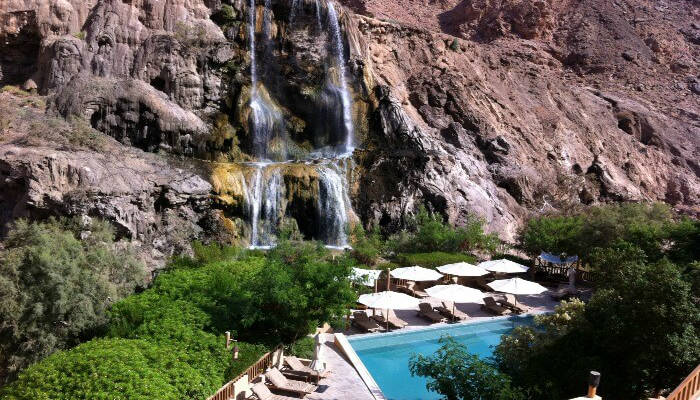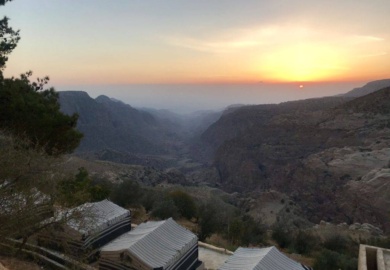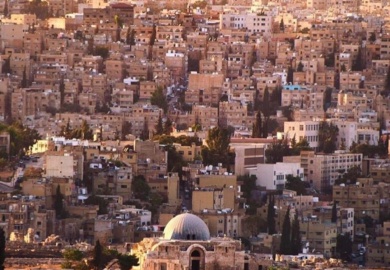DEAD SEA
Without a doubt the world’s most amazing place, the Jordan Rift Valley is a dramatic, beautiful landscape, which at the Dead Sea, is over 400m (1,312 ft.) below sea level. The lowest point on the face of the earth, this vast stretch of water receives a number of incoming rivers, including the River Jordan. Once the waters reach the Dead Sea they are land-locked and have nowhere to go, so they evaporate, leaving behind a dense, rich, cocktail of salts and minerals that supply industry, agriculture and medicine with some of its finest products.
The Dead Sea is flanked by mountains to the east and the rolling hills of Jerusalem to the west, giving it an almost other-worldly beauty. Although sparsely populated and serenely quiet now, the area is believed to have been home to five Biblical cities: Sodom, Gomorrah, Adman, Zebouin and Zoar (Bela).
One of the most spectacular natural and spiritual landscapes in the world, the Jordanian east coast of the Dead Sea has evolved into a major hub of both religious and health & wellness tourism in the region. A series of good roads, excellent hotels with spa and fitness facilities, as well as archaeological and spiritual discoveries make this region as enticing to today’s international visitors as it was to kings, emperors, traders, prophets and pilgrims in antiquity.
The leading attraction at the Dead Sea is the warm, soothing, super salty water itself – some ten times saltier than sea water, and rich in chloride salts of magnesium, sodium, potassium, bromine and several others. The unusually warm, incredibly buoyant and mineral-rich waters have attracted visitors since ancient times, including King Herod the Great and the beautiful Egyptian Queen, Cleopatra. All of whom have luxuriated in the Dead Sea’s rich, black, stimulating mud and floated effortlessly on their backs while soaking up the water’s healthy minerals along with the gently diffused rays of the Jordanian sun.
HISTORY & CULTURE
The Jordan Valley is part of the Great Rift Valley that runs from Turkey to east Africa, formed by a series of geological upheavals millions of years ago. The Dead Sea originally stretched the entire 360km from Aqaba, in the south, to Lake Tiberias (the Sea of Galilee) in the north.
The therapeutic water of the Dead Sea, combined with the valley’s fertile land and warm climate, have attracted people to live, hunt and farm in the area since the Stone Age. Over 200 archaeological sites have been discovered, but there are believed to be many more.
Many of the historical sites around the Dead Sea region are intrinsically linked with biblical events.
.ECO & NATURE
The growing demand on water consumption in the region has seen the natural inflow to the Dead Sea diminish rapidly over the past years. So much so, that there is a risk of the sea drying up altogether within the next 50 years. This would be a devastating loss, not only for tourism and the economy, but also for the loss of the Dead Sea’s unique properties, the surrounding environment, and its flora and fauna.
The Mujib Biosphere Reserve is the lowest-altitude nature reserve in the world, with its spectacular array of scenery near the East coast of the Dead Sea. The reserve is located within the deep Wadi Mujib gorge which enters the Dead Sea at 410m below sea level. The Reserve extends to the Karak and Madaba mountains to the North and South, reaching 900m above sea level in some places. This 1,300m variation in elevation, combined with the valley’s year-round water flow from seven tributaries, means that the Wadi Mujib enjoys a magnificent biodiversity that is still being explored and documented today.
Over 420 species of plants, 102 species of permanent and migratory birds, and10 species of carnivores including the Red Fox, Blandford Fox, Hyena, Jackal, Wild Cat, Caracal, Badger, Mongoose, Wolf and Arabian Leopard have been recorded to date. Some of the remote mountain and valley areas are difficult to reach, offering a safe haven to various species of cats, goats and other mountain animals.
Mujib’s sandstone cliffs are an ideal habitat for one of the most beautiful mountain goats in the world, the Nubian Ibex. The natural Ibex herds have declined over the years due to over hunting, prompting Jordan’s Royal Society for the Conservation of Nature to establish a captive-breeding programme for the Ibex within the Mujib Biosphere Reserve.
Mujib is also home to carnivorous species such as the Caracal, a medium-sized cat distinguished by its black and white ear tufts. An agile and powerful hunter, the Caracal can be spotted in action in the rocky valley of Mujib, using its amazing jumping power to catch airborne prey.
RELIGION & FAITH
For Christians, this region inspires their faith. This is the place where God first spoke to Man. It is the Holy Land where God gave his Ten Commandments to Moses, where Job suffered and was rewarded for his faith, where Jacob wrestled with the angel of God, and where Jesus was baptized by John.
In the Book of Genesis, God refers to the Jordan River Valley around the Dead Sea as the “Garden of the Lord,” and it is believed to be the location of the Garden of Eden.
The infamous cities of Sodom and Gomorrah and many other places were the subjects of dramatic and enduring Old Testament stories, including that of Lot, whose wife turned into a pillar of salt for disobeying God’s will.
Twelve hundred years after the death of Moses, the Bible claims that John the Baptist preached and baptized in a place called Bethany Beyond the Jordan. This place has now been identified as Tall Al-Kharrar and Elijah’s Hill.
Islamic Sites
Many of these sites and others in the region are also significant holy places for Muslims, who can find a plethora of religious destinations that are important to the development of Islam, the religion followed by the majority of Jordanians today.
Visit the tombs of the Prophet Mohammad’s (PBUH) venerable companions and military leaders who fell in battle or became victims of the Great Plague (Amwas Plague) in the 18th year after the Hijra.
Abu Ubeida Amer Bin Al-Jarrah
A relative of the Prophet Mohammad (PBUH) and one of the first converts to Islam. He participated in all major events and was one of the ‘Blessed Ten’ to whom the Prophet promised paradise. As supreme commander of the Northern Muslim Army, he successfully conquered Syria and was dubbed by the Prophet as “The Trustee of the Nation.” At the age of 58 he fell victim to the Great Plague that spread through Greater Syria. His tomb, in the Central Jordan Valley, is a major Islamic centre with a mosque, library and cultural centre.
Mo’ath Bin Jabal
A venerable companion and one of the six charged with the task of compiling the Holy Quran during the life of the Prophet Mohammad (PBUH). He was sent by the Prophet as counselor to the people of Yemen and also took part in the Aqaba Allegiance Convention between the Prophet and his supporters from Medina. He died at the age of 38 in the Jordan Valley, having spent his short life teaching faith and the Holy Qu’ran. A modern building with five domes houses his tomb.
Shurhabil Bin Hasanah
A venerable companion and one of the early Muslims who fled to Abyssinia. Known for his strong faith, intelligence, bravery and administrative abilities, he participated in the Battle of Yarmouk and the conquest of Jerusalem. He also commanded the army assigned to the conquest of Jordan. He later became the governor of a province in Greater Syria. He died from the plague on the same day as the venerable companion, Abu Ubeida Amer bin Al-Jarrah.
Amir Bin Abi Waqqas
A maternal cousin of the Prophet Mohammad (PBUH) and the eleventh man to convert to Islam. He migrated to Abyssinia and fought in the battle of Uhud. He was later entrusted with carrying messages from the commanders of the Muslim army to the Caliph in Medina and became deputy to the venerable companion Abu Ubeida during his governorship in Syria. His tomb is located within a new building erected on vaults, in the village of Waqqas, in the Northern Jordan Valley.
Derar Bin Al-Azwar
A venerable companion of the Prophet Mohammad (PBUH). He was a poet and fierce warrior, who fought in the wars of Apostasy and took part in the conquest of Greater Syria, alongside his distinguished sister, Khawlah bint Al-Azwar. A victim of the Great Plague, he died in the 18th year after the Hijra. His tomb is located in a mosque superimposed by a dome in the town of Deir ‘Alla.
Bethany Beyond the Jordan
The Bible confirms that John preached and baptized in a place called Bethany Beyond the Jordan, which Byzantine and Medieval texts, as well as modern archaeology identify as the site called Tall Al-Kharrar and Elijah’s Hill. Stunning archaeological discoveries since 1996 reveal pottery, coins and architectural remains from a 5th century Byzantine monastery.
They also reveal an earlier 3rd century building with fine mosaics and what is known as a Christian “prayer hall.” If this is correct, it might be one of the earliest Christian prayer facilities anywhere in the world. Also identified is the cave where John the Baptist lived, according to numerous Byzantine pilgrims’ texts. The cave was turned into a church and a freshwater channel running from the cave, purportedly used by John for baptizing, can still be visited today.
Madaba
A city of mosaics. Madaba sites include St. George’s Church, with a mosaic map of the Holy Land, the Madaba Archaeological Park, the Madaba Museum, the Church of the Apostles, and a Mosaic School.
Mount Nebo
The place where it is believed that Moses was buried and the most revered Holy site in Jordan. When you stand at the top of this mountain, you can see, as Moses did, the vast panorama that encompasses the Jordan River Valley, the Dead Sea, Jericho and Jerusalem.
According to legend, this is also the place where Jeremiah hid the Ark of the Covenant. It was a place of pilgrimage for early Christians and Mount Nebo’s first church was built in the 4th century to commemorate the site of Moses’ death.
Six tombs from different periods have been found hollowed out of the rock beneath the mosaic-covered floor of the church. In the present presbytery you can see remnants of mosaics, the earliest of which is a panel with a braided cross.
The Serpentine Cross, which stands just outside the sanctuary, is symbolic of the brass serpent taken by Moses into the desert and the cross upon which Jesus was crucified.
Mukawir
The remains of King Herod’s hilltop palace of Machaerus still stands. This is the place where Herod Antipas beheaded John the Baptist at the Salome’s request.
Lot’s Cave
A Byzantine monastic complex, it included a church with mosaic floors, a reservoir, living quarters, a burial chamber and a cave that appears to have been presented to pilgrims as the place where Lot and his daughters took refuge after the destruction of Sodom.
Lot’s Sanctuary, one of the most significant archaeological discoveries in Jordan, is located near modern Ghor Al Safi. A dried pillar of salt nearby is said to be the remains of Lot’s wife, who disobeyed God’s warning not to look back as she fled Sodom.
. Tall Deir Alla
At Tall Deir Alla, excavations have revealed almost continuous habitation from 1600-400 BC. The site contains evidence of metalworking, grain storage farming and seasonal migration, as well as a cemetery. Archaeologists believe this may be the biblical site of Succoth.
Tall Saadiyyeh
An important walled town for most of the Bronze and Iron Ages (3200-536 BC). It had a large Caravanserai (Inn) in the early Islamic period, and is believed to be associated with the biblical sites of Zaphon and Zarthan.
Bab Ad-Dhraa and Numeira
Along the south east coast of the Dead Sea are the sites of Bab Ad-Dhraa and Numeira, both plausible candidates for the biblical sites of Sodom and Gomorrah (in the Book of Genesis, God destroyed these places because He was displeased with the wickedness of the inhabitants). Bab Ad-Dhraa was inhabited for about 1000 years during the early Bronze Age. Nomads used this place as a cemetery, burying their dead in multiple shaft tombs and charnel houses. Numeira, 14km to the south, was a large hilltop walled town that lasted for around a century during the Early Bronze Age period. A 40cm layer of ash indicates that this ancient place suffered a fiery destruction.




Facebook Comments